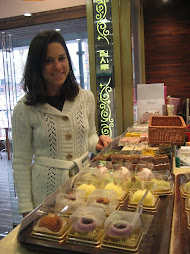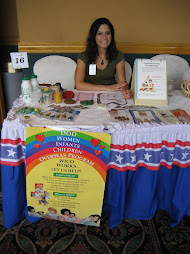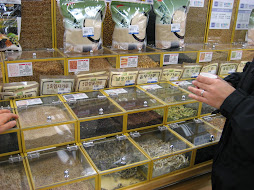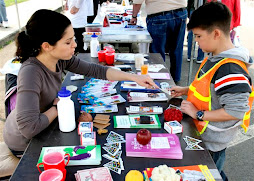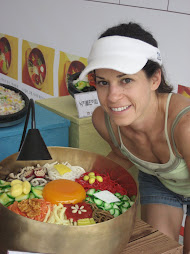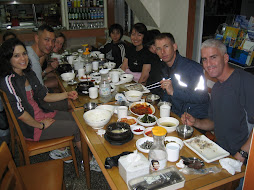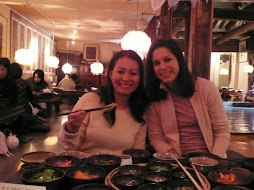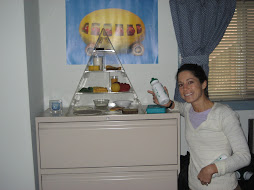 Pang ap bang literally means "bread without fish." The fish-shaped cooked dough is actually filled with sweet red bean, not fish paste. It costs 1000 won for three. (Less than a dollar these days, with a rate of 1401 won per dollar as of Nov 30.)
Pang ap bang literally means "bread without fish." The fish-shaped cooked dough is actually filled with sweet red bean, not fish paste. It costs 1000 won for three. (Less than a dollar these days, with a rate of 1401 won per dollar as of Nov 30.)Sunday, November 23, 2008
Fish Bread
Cold weather indicates the beginning of fishing season. By fishing, I mean finding a street vendor who sells pang ap bang. Pang ap bang literally means "bread without fish." The fish-shaped cooked dough is actually filled with sweet red bean, not fish paste. It costs 1000 won for three. (Less than a dollar these days, with a rate of 1401 won per dollar as of Nov 30.)
Pang ap bang literally means "bread without fish." The fish-shaped cooked dough is actually filled with sweet red bean, not fish paste. It costs 1000 won for three. (Less than a dollar these days, with a rate of 1401 won per dollar as of Nov 30.)
 Pang ap bang literally means "bread without fish." The fish-shaped cooked dough is actually filled with sweet red bean, not fish paste. It costs 1000 won for three. (Less than a dollar these days, with a rate of 1401 won per dollar as of Nov 30.)
Pang ap bang literally means "bread without fish." The fish-shaped cooked dough is actually filled with sweet red bean, not fish paste. It costs 1000 won for three. (Less than a dollar these days, with a rate of 1401 won per dollar as of Nov 30.)Food Expo at COEX Exhibition Center
On Sunday Eric and I took the Metro to the COEX mall. First, I wandered around the food court. A special Red Mango with self-serve bits of fruits to top frozen yogurt. Pinkberry in Southern California is a spawn of Red Mango. I always wondered who created such an odd name for a frozen yogurt place. Now it makes sense, given Korea's penchant for off-the-wall English names. The frozen yogurt is sour and low in calories.
A special Red Mango with self-serve bits of fruits to top frozen yogurt. Pinkberry in Southern California is a spawn of Red Mango. I always wondered who created such an odd name for a frozen yogurt place. Now it makes sense, given Korea's penchant for off-the-wall English names. The frozen yogurt is sour and low in calories.
 Each fast food place had its own water cooler.
Each fast food place had its own water cooler.
 Here is the peaceful, airy food court.
Here is the peaceful, airy food court.
 A special Red Mango with self-serve bits of fruits to top frozen yogurt. Pinkberry in Southern California is a spawn of Red Mango. I always wondered who created such an odd name for a frozen yogurt place. Now it makes sense, given Korea's penchant for off-the-wall English names. The frozen yogurt is sour and low in calories.
A special Red Mango with self-serve bits of fruits to top frozen yogurt. Pinkberry in Southern California is a spawn of Red Mango. I always wondered who created such an odd name for a frozen yogurt place. Now it makes sense, given Korea's penchant for off-the-wall English names. The frozen yogurt is sour and low in calories. Each fast food place had its own water cooler.
Each fast food place had its own water cooler. Here is the peaceful, airy food court.
Here is the peaceful, airy food court.Next, I headed to the Food Expo, while Eric explored a cycling expo. I paid 3,000 won to look at foods offered by different vendors. It was the perfect event for a food service manager. Many people were taking photos of the products, so I felt at home.
A few items stood out.
Red yeast rice:
Random Potluck Items
On Saturday night we had a potluck & games night at our apartment. Everyone brought food to share: Nothing to describe since everyone brought American food.
Nothing to describe since everyone brought American food.
 Nothing to describe since everyone brought American food.
Nothing to describe since everyone brought American food.Thursday, November 20, 2008
Tea Time
One day I was at a Korean friend's house, and she gave me a glass of cold tea. Its mild taste resembled that of whole grains. When I asked her about it, she opened her freezer and gave me a baggie of twigs. She told me to boil the twigs in a pot of water to make the tea. Koreans use it as a diuretic, she said.  This baggie has been sitting in the back of my freezer for the past six months. Somehow I can not muster the courage to boil sticks in water. Maybe next time we go camping I'll give it a try. It seems like an outdoor activity.
This baggie has been sitting in the back of my freezer for the past six months. Somehow I can not muster the courage to boil sticks in water. Maybe next time we go camping I'll give it a try. It seems like an outdoor activity.
 This baggie has been sitting in the back of my freezer for the past six months. Somehow I can not muster the courage to boil sticks in water. Maybe next time we go camping I'll give it a try. It seems like an outdoor activity.
This baggie has been sitting in the back of my freezer for the past six months. Somehow I can not muster the courage to boil sticks in water. Maybe next time we go camping I'll give it a try. It seems like an outdoor activity. Fortunately, E-mart sells a pre-made version:  Speaking of tea, a new contractor stopped by my office. She gave me to packets of tea, which she had trouble describing in English. One is a green tea with brown rice (two of Korea's most popular ingredients) and the other is as yet unidentified:
Speaking of tea, a new contractor stopped by my office. She gave me to packets of tea, which she had trouble describing in English. One is a green tea with brown rice (two of Korea's most popular ingredients) and the other is as yet unidentified:
 Speaking of tea, a new contractor stopped by my office. She gave me to packets of tea, which she had trouble describing in English. One is a green tea with brown rice (two of Korea's most popular ingredients) and the other is as yet unidentified:
Speaking of tea, a new contractor stopped by my office. She gave me to packets of tea, which she had trouble describing in English. One is a green tea with brown rice (two of Korea's most popular ingredients) and the other is as yet unidentified: Monday, November 17, 2008
Piano Man Does Korea
On Saturday night we went to Olympic Stadium for a Billy Joel concert. I hadn't been to an indoor concert since MC Hammer in the late eighties! Anyway, here was the view of the stadium, where Seoul also hosted the Olympics in 1988: For some reason, I assumed that the food vendors would sell standard stadium fare - burgers, beer, pizza, fries, hot dogs. Instead, vendors sold street food from makeshift stands:
For some reason, I assumed that the food vendors would sell standard stadium fare - burgers, beer, pizza, fries, hot dogs. Instead, vendors sold street food from makeshift stands: Concert-goers dined on ramen, tteokpokki, soup, extra greasy dough-covered hot dogs, and canned Cass Beer.
Concert-goers dined on ramen, tteokpokki, soup, extra greasy dough-covered hot dogs, and canned Cass Beer. Could you imagine trying to take a bowl of soup back to your seat?
Could you imagine trying to take a bowl of soup back to your seat?
 For some reason, I assumed that the food vendors would sell standard stadium fare - burgers, beer, pizza, fries, hot dogs. Instead, vendors sold street food from makeshift stands:
For some reason, I assumed that the food vendors would sell standard stadium fare - burgers, beer, pizza, fries, hot dogs. Instead, vendors sold street food from makeshift stands: Concert-goers dined on ramen, tteokpokki, soup, extra greasy dough-covered hot dogs, and canned Cass Beer.
Concert-goers dined on ramen, tteokpokki, soup, extra greasy dough-covered hot dogs, and canned Cass Beer. Could you imagine trying to take a bowl of soup back to your seat?
Could you imagine trying to take a bowl of soup back to your seat?
Special Starbucks
Sunday, November 16, 2008
Rice Cake Gift Box
I received an unexpected gift at work from some Korean vendors: A box of Korean rice cakes or tteok!
A box of Korean rice cakes or tteok!
 Of course I sampled everything right away. I took a few bites of each one. Because the texture was gummy and dense, it was difficult to eat much more. The pale orange one tasted like fresh pumpkin, mildly sweetened.
Of course I sampled everything right away. I took a few bites of each one. Because the texture was gummy and dense, it was difficult to eat much more. The pale orange one tasted like fresh pumpkin, mildly sweetened. The second one tasted like rice seasoned with soy sauce. I did not care for it.
The second one tasted like rice seasoned with soy sauce. I did not care for it.
 A box of Korean rice cakes or tteok!
A box of Korean rice cakes or tteok! Of course I sampled everything right away. I took a few bites of each one. Because the texture was gummy and dense, it was difficult to eat much more. The pale orange one tasted like fresh pumpkin, mildly sweetened.
Of course I sampled everything right away. I took a few bites of each one. Because the texture was gummy and dense, it was difficult to eat much more. The pale orange one tasted like fresh pumpkin, mildly sweetened. The second one tasted like rice seasoned with soy sauce. I did not care for it.
The second one tasted like rice seasoned with soy sauce. I did not care for it.Tuesday, November 11, 2008
Hike to Ulsanbawi (Ulsan Rock)
The next morning we purchased breakfast at a mom-and-pop convenience store. I found two healthy items, Dr. You's "Hi-Protein Bars" and Kellogg's whole grain crackers with sesame seeds. (I also drank a protein shake from home.)

The Nutrition Facts label included the calories for the crackers plus milk. I've only seen milk included on food labels for cereal in the United States.
 We started the morning with a tram ride to a mountain top (elevation no more than a few thousand feet). We were on the first tram to the top! No crowds for us. The lady at the snack shop was shaping hotteok dough. I would have bought one, but our return tram arrived.
We started the morning with a tram ride to a mountain top (elevation no more than a few thousand feet). We were on the first tram to the top! No crowds for us. The lady at the snack shop was shaping hotteok dough. I would have bought one, but our return tram arrived.
 A fresh stream of water kept these beverages cold (See the non-liquid snack item in the mix?):
A fresh stream of water kept these beverages cold (See the non-liquid snack item in the mix?):


The Nutrition Facts label included the calories for the crackers plus milk. I've only seen milk included on food labels for cereal in the United States.
The Dr. You brand seems to have cornered the market for healthy snacks. I wouldn't even call the snacks 'healthy.' Rather, like other so-called healthy snacks, they are an improvement over other processed, machine-made foods.
 We started the morning with a tram ride to a mountain top (elevation no more than a few thousand feet). We were on the first tram to the top! No crowds for us. The lady at the snack shop was shaping hotteok dough. I would have bought one, but our return tram arrived.
We started the morning with a tram ride to a mountain top (elevation no more than a few thousand feet). We were on the first tram to the top! No crowds for us. The lady at the snack shop was shaping hotteok dough. I would have bought one, but our return tram arrived.Next we hiked to the top of Ulsanbawi, where we had a great view of the valleys, neighboring towns, and beaches. It was rainy so the trail was empty. We didn't pack snacks or drinks because we knew the trail was very developed.
In fact, the snack stand below resembled some restaurants in Seoul, plastic chairs and all:
 A fresh stream of water kept these beverages cold (See the non-liquid snack item in the mix?):
A fresh stream of water kept these beverages cold (See the non-liquid snack item in the mix?):
I was surprised to see the eggshells and other trash next to the grill:  Alcohol and ramen seem to be popular trail foods (above left in photo).
Alcohol and ramen seem to be popular trail foods (above left in photo).
 On the way back, ajummas beckoned us to buy chestnuts. We saved our appetites for snack bar foods at the tram's building. Eric played it safe with waffles, coffee, and a ham sandwich. I played it safe, too, with the bibimbap:
On the way back, ajummas beckoned us to buy chestnuts. We saved our appetites for snack bar foods at the tram's building. Eric played it safe with waffles, coffee, and a ham sandwich. I played it safe, too, with the bibimbap:
 Alcohol and ramen seem to be popular trail foods (above left in photo).
Alcohol and ramen seem to be popular trail foods (above left in photo). On the way back, ajummas beckoned us to buy chestnuts. We saved our appetites for snack bar foods at the tram's building. Eric played it safe with waffles, coffee, and a ham sandwich. I played it safe, too, with the bibimbap:
On the way back, ajummas beckoned us to buy chestnuts. We saved our appetites for snack bar foods at the tram's building. Eric played it safe with waffles, coffee, and a ham sandwich. I played it safe, too, with the bibimbap:Mr. Pizza Loves Women
That evening we stayed at a $25 dollar-a-night motel near Outer Seorak. We decided to drive back to Seokcho, the closest large town, to find a pizza place. We scoured the city until we finally found one block with a Mr. Pizza, a Bueno Pizza, and a Pizza Hut (which we unfortunately did not notice until after dinner).
We chose Mr. Pizza. The hostess lead us to our seat. A few minutes passed until an English-speaking server could be rousted out of the kitchen. Here is a picture of the menu cover:

Apparently, Mr. Pizza loves women and knows how to please them. He serves ingredients that women love: dough with wheat from Canada, fresh cheese, beef from Korea or Australia (NOT the U.S.).
 Mr. Pizza even did a survey to determine women's favorite ingredients. He then created a speciality pizza with women's faves. Eric chose a dull-looking spaghetti plate:
Mr. Pizza even did a survey to determine women's favorite ingredients. He then created a speciality pizza with women's faves. Eric chose a dull-looking spaghetti plate: He called it "spaghetti from a can." The pickles added an interesting touch to the meal. Ironically, I chose the women's pizza before learning about Mr. Pizza's survey.
He called it "spaghetti from a can." The pickles added an interesting touch to the meal. Ironically, I chose the women's pizza before learning about Mr. Pizza's survey.
 The pizza contained fresh mozzarella cheese, vegetables, spicy chicken, mashed sweet potato, golden crust, and swirls of blue cheese sauce. I said anyo to the blue cheese sauce.
The pizza contained fresh mozzarella cheese, vegetables, spicy chicken, mashed sweet potato, golden crust, and swirls of blue cheese sauce. I said anyo to the blue cheese sauce. The pizza was tasty in a spicy, flavorful Korean way. Fortunately, the "golden crust" referred to the sweet potato stuffed in the turtle skin. Delicious!
The pizza was tasty in a spicy, flavorful Korean way. Fortunately, the "golden crust" referred to the sweet potato stuffed in the turtle skin. Delicious!
We chose Mr. Pizza. The hostess lead us to our seat. A few minutes passed until an English-speaking server could be rousted out of the kitchen. Here is a picture of the menu cover:

Apparently, Mr. Pizza loves women and knows how to please them. He serves ingredients that women love: dough with wheat from Canada, fresh cheese, beef from Korea or Australia (NOT the U.S.).
 Mr. Pizza even did a survey to determine women's favorite ingredients. He then created a speciality pizza with women's faves. Eric chose a dull-looking spaghetti plate:
Mr. Pizza even did a survey to determine women's favorite ingredients. He then created a speciality pizza with women's faves. Eric chose a dull-looking spaghetti plate: He called it "spaghetti from a can." The pickles added an interesting touch to the meal. Ironically, I chose the women's pizza before learning about Mr. Pizza's survey.
He called it "spaghetti from a can." The pickles added an interesting touch to the meal. Ironically, I chose the women's pizza before learning about Mr. Pizza's survey. The pizza contained fresh mozzarella cheese, vegetables, spicy chicken, mashed sweet potato, golden crust, and swirls of blue cheese sauce. I said anyo to the blue cheese sauce.
The pizza contained fresh mozzarella cheese, vegetables, spicy chicken, mashed sweet potato, golden crust, and swirls of blue cheese sauce. I said anyo to the blue cheese sauce. The pizza was tasty in a spicy, flavorful Korean way. Fortunately, the "golden crust" referred to the sweet potato stuffed in the turtle skin. Delicious!
The pizza was tasty in a spicy, flavorful Korean way. Fortunately, the "golden crust" referred to the sweet potato stuffed in the turtle skin. Delicious!Monday, November 10, 2008
Sunday at Seorksan National Park
Thanks to a holiday weekend, Eric and I headed to Seoraksan National Park for a few days. I was amazed by the beauty and serenity of the park. What a needed break from the hustle-and-bustle of Seoul.
I loved how the rest areas became quaint and deserted the farther we drove from Seoul. (A typical rest area contains hundreds of cars and buses, bathrooms with fifty stalls, and people everywhere.) At this convenience store, men drank tiny paper cups of coffee while huddled around a table. Eric actually needed to use his Korean language skills (and the universal language of hand gestures) to order his cappuccino.
At this convenience store, men drank tiny paper cups of coffee while huddled around a table. Eric actually needed to use his Korean language skills (and the universal language of hand gestures) to order his cappuccino.
The seating area doubled as a stock room for fresh produce:

We stopped by Naksan Beach for lunch at Buy-the-Way market. We avoided local restaurants based on the plethora of seafood places. Even the souvenir merchants were selling fish: We hiked to a Buddhist temple overlooking the ocean. Hikers lined up to taste the fresh water on tap:
We hiked to a Buddhist temple overlooking the ocean. Hikers lined up to taste the fresh water on tap:
I loved how the rest areas became quaint and deserted the farther we drove from Seoul. (A typical rest area contains hundreds of cars and buses, bathrooms with fifty stalls, and people everywhere.)
 At this convenience store, men drank tiny paper cups of coffee while huddled around a table. Eric actually needed to use his Korean language skills (and the universal language of hand gestures) to order his cappuccino.
At this convenience store, men drank tiny paper cups of coffee while huddled around a table. Eric actually needed to use his Korean language skills (and the universal language of hand gestures) to order his cappuccino.
The seating area doubled as a stock room for fresh produce:

We stopped by Naksan Beach for lunch at Buy-the-Way market. We avoided local restaurants based on the plethora of seafood places. Even the souvenir merchants were selling fish:
 We hiked to a Buddhist temple overlooking the ocean. Hikers lined up to taste the fresh water on tap:
We hiked to a Buddhist temple overlooking the ocean. Hikers lined up to taste the fresh water on tap:Friday, November 7, 2008
Variations of a Theme
Bibimbap is the "safety" food I order in Korea. It's simply rice, vegetables, egg, the occasional meat, and red pepper paste. The variations, though, are endless. Bibimbap even varies according to region. Jeonju Bibimbap tops the list of varietals; many restaurants specialize in this style.
Jinju Bibimbap is famous for its small quantity, and Tongyeong Bibimbap uses a lot of salted raw seaweed and seasoned cooked radish. A region's speciality produce can usually be found in a bowl of its bibimbap. This hearty, hot version contained squid and mushrooms. Mom and Aunt Bev ordered it by themselves at Seoul Tower.
This hearty, hot version contained squid and mushrooms. Mom and Aunt Bev ordered it by themselves at Seoul Tower.
 The big black bowls contained large helpings. This version included the typical vegetables. Sandy and I found this place during one of our evening walks in Itaewon.
The big black bowls contained large helpings. This version included the typical vegetables. Sandy and I found this place during one of our evening walks in Itaewon.
Jinju Bibimbap is famous for its small quantity, and Tongyeong Bibimbap uses a lot of salted raw seaweed and seasoned cooked radish. A region's speciality produce can usually be found in a bowl of its bibimbap.
 This hearty, hot version contained squid and mushrooms. Mom and Aunt Bev ordered it by themselves at Seoul Tower.
This hearty, hot version contained squid and mushrooms. Mom and Aunt Bev ordered it by themselves at Seoul Tower. The big black bowls contained large helpings. This version included the typical vegetables. Sandy and I found this place during one of our evening walks in Itaewon.
The big black bowls contained large helpings. This version included the typical vegetables. Sandy and I found this place during one of our evening walks in Itaewon.
Subscribe to:
Comments (Atom)























